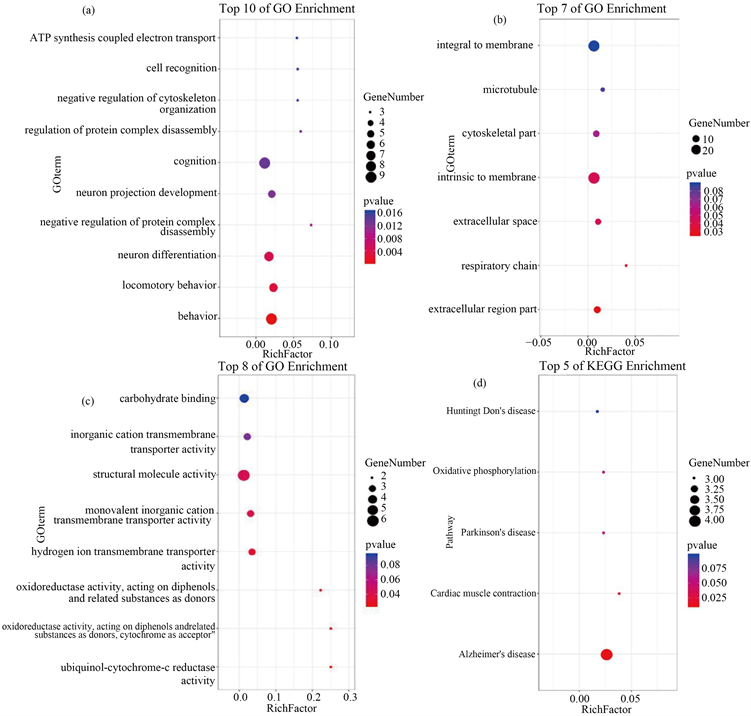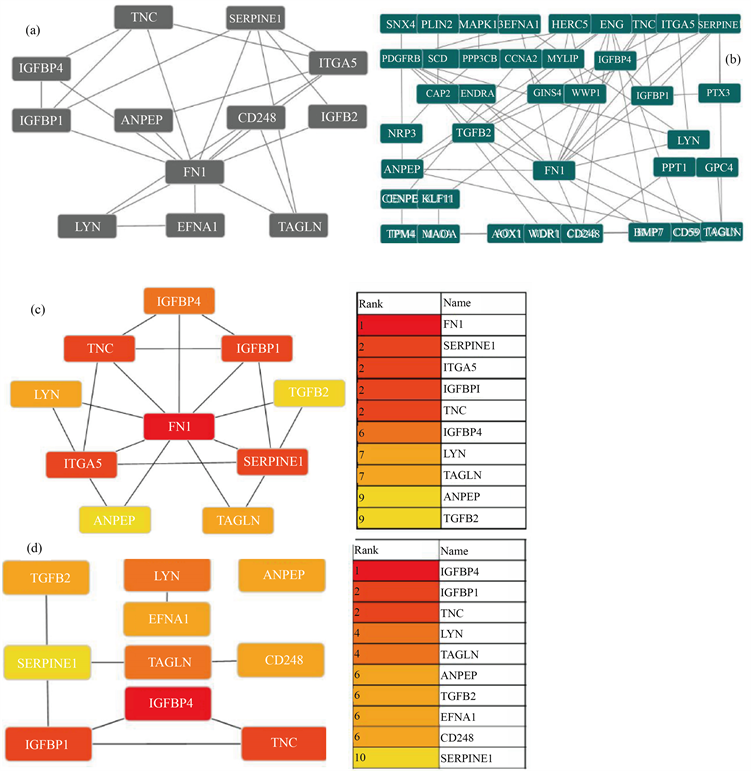摘要:
背景:肺癌是源于支气管黏膜上皮的恶性肿瘤,发病率和死亡率均居恶性肿瘤首位,由于发病隐匿,早期症状不明显,就诊时大多属晚期,5年总生存率(overall survival, OS)仅为19%,当出现远处转移时其生存率更低。为了筛选肺癌发生发展的潜在基因,本研究从GEO数据库中获得GSE136043和GSE146460进行生物信息学分析。方法:首先,利用GEO2R识别差异表达基因(DEGs),通过GO (Gene Ontology)和KEGG (Kyoto Encyclopedia of Genes and Genomes)分析对差异表达基因(DEGs)进行功能注释。利用STRING工具构建蛋白–蛋白相互作用(PPI)网络,挖掘出最重要的模块和核心基因。结果:共鉴定出73个差异表达基因。差异表达基因的功能变化主要集中在ATP合成偶联的过程,细胞识别,细胞膜、骨架等结构形成和多种酶或转运体如碳水化合物结合和无机阳离子跨膜转运体活性等方面。LYN、TNC、TAGLN、IGFBP1、ANPEP、SERPINE1、IGFBP4、TGFB2基因被鉴定为核心基因。结论:综上所述,本研究中发现的差异表达基因和核心基因有可能成为潜在的诊断和治疗靶点。
Abstract:
Background: Lung cancer is a malignant tumor that originates from bronchial epithelial epithelium. Incidence rate and mortality rate are the highest in malignant tumors. Because of the early onset of symptoms, the majority of patients are late. The overall survival (OS) in five years is only 19%. In order to screen the potential genes for the development of lung cancer, we obtained GSE136043 and GSE146460 from GEO Database for bioinformatics analysis. Methods: Firstly, differential expression genes (DEGs) were identified by geo2r, and their functions were annotated by GO and KEGG analysis. Using STRING tools to construct protein-protein interaction (PPI) network, the most important modules and hub genes were mined. Results: A total of 73 differentially expressed genes were identified. The functional changes of differentially expressed genes mainly focus on the process of ATP synthesis coupling, cell recognition, structure formation of cell membrane and cytoskeleton, and activities of various enzymes or transporters such as carbohydrate binding and inorganic cation transmembrane transporters. LYN, TNC, TAGLN, IGFBP1, ANPEP, SERPINE1, IGFBP4, TGFB2 were identified as hub genes. Conclusion: In conclusion, the differentially expressed genes and core genes found in this study may become potential diagnostic and therapeutic targets.
1. 引言
肺癌是临床最常见的恶性肿瘤之一,它来源于支气管粘膜上皮,严重威胁人类健康和生命安全 [1]。尽管我们对肺癌的风险、发展、免疫控制和治疗选择的理解有了提高,但它仍然是目前死亡人数最多的癌症。吸烟是肺癌发展的主要危险因素;非烟草风险因素包括环境和职业暴露、慢性肺病、肺部感染和生活方式因素 [2]。尽管目前各种免疫治疗、靶向药物等方法均应用于肺癌治疗,但由于患者确诊即中晚期的比例较高以及肿瘤出现侵袭转移等原因,导致肺癌治疗疗效欠佳 [3]。因此深入研究肺癌的分子机制尤为重要。
生物信息学是利用生命科学与计算机科学技术,挖掘分析生物大数据并探索疾病发病原理的一门新学科。通过公共大数据的微阵列分析可以获取大量疾病患者与正常人的基因数据,进而可以找出与疾病相关的异常表达的基因 [4] [5]。微阵列分析技术能够同时获取数万个基因的表达信息,进而发掘与疾病发生发展相关的基因组学改变。目前已有大量研究使用生物信息学技术来分析肿瘤进展中的差异表达基因,进而研究其在生物过程、分子功能和信号通路方面的作用,并阐明疾病的发病机制,为早期诊断及治疗提供理论依据 [6] [7]。
SERPINE1基因编码丝氨酸蛋白酶抑制剂超家族成员,是组织型纤溶酶原激活物(tPA)和尿激酶(uPA)的主要抑制剂。有研究发现,SERPINE1可以促进膀胱移行细胞癌细胞增殖 [8]、乳腺癌细胞侵袭迁移 [9] [10],从而促进肿瘤进展。IGFBP1基因编码是一种分泌性蛋白,该蛋白具有调节细胞增殖、迁移、侵袭及黏附等生物学活性。经研究发现其影响胃癌 [11]、肝细胞癌 [12] 的侵袭转移。然而目前其与肺癌之间的关系尚不清楚。
因此本文拟利用生物信息学技术挖掘肺癌与正常组织之间的相关核心基因,并进行富集分析、通路分析和生存分析。利用公共数据验证核心基因在肺癌中的作用。
2. 材料和方法
2.1. 数据集
我们从Gene Expression Omnibus (GEO)数据库下载了两个基因图谱,GSE136043和GSE146460 (https://www.ncbi.nlm.nih.gov/geo/)。GSE136043包括5个肺腺癌样本和5个癌周组织样本,GSE146460包括3个肺腺癌样本和3个癌周组织样本。
2.2. 差异转录基因(DEGs)标识
我们应用了GEO2R (http://www.ncbi.nlm.nih.gov/geo/geo2r),一个基于GEOquery和limmar软件包的在线工具,用于识别食管癌和正常组之间的差异转录基因。临界标准为P值 < 0.05,log(FC) > 1或log(FC) < −1。
2.3. 差异转录基因注释
DAVID (https://david.ncifcrf.gov/home.jsp)和Metascape (http://metascape.org/gp/index.html)两个网站是对基因进行生物过程(BP)、细胞成分(CC)、分子功能(MF)和KEGG (Kyoto Encyclopedia of Genes and Genomes)分析的两种强有力的注释工具。我们通过DAVID和Metascape注释了共同差异转录基因的功能。
2.4. 蛋白质相互作用网络的构建
检索相互作用基因的搜索工具STRING (http://string-db.org),可将差异转录基因转换为表达蛋白,构建蛋白–蛋白相互作用(PPI)网络。我们通过STRING得到了共同的差异表达基因的蛋白–蛋白相互作用(PPI)网络,并用Cytoscape (3.7.2版)对其进行了可视化处理。
2.5. 核心基因的鉴定与表达
分子复合物检测工具(MCODE) (1.6.1版)是一个开放的Cytoscape插件,被用于识别蛋白-蛋白相互作用(PPI)网络中的重要模块。标准是最大深度 = 100,MCODE评分 > 5,临界值 = 2,k评分 = 2,节点评分临界值 = 0.2 [13]。此外,我们还应用cytoHubb从MCODE的核心模块中筛选出核心基因,并用MCC、DMNC两种不同的算法对其进行排序。然后找出两种算法之间的共同核心基因,并绘制热图。
3. 结果
3.1. 差异转录基因(DEGs)
两个火山图显示了GSE136043和GSE146460中的差异转录基因(图1(a)和图1(b))。韦恩图显示了两个数据集共有的73个差异转录基因(图2)。
 (a) (b)
(a) (b)
Figure 1. Two volcano plots present the DEGs. (a) The DEGs in the GSE136043; (b) The DEGs in the GSE146460
图1. 两个火山图显示了差异转录基因。(a) GSE136043型中的差异表达基因;(b) GSE146460中的差异表达基因

Figure 2. The common DEGs between GSE136043 and GSE146460
图2. GSE136043和GSE146460型中共同的差异表达基因
3.2. 差异转录基因注释
Metascape的富集分析如图3所示。与生物过程(BP)、细胞成分(CC)、分子功能(MF)和KEGG富集分析相关的DEG分别显示在气泡图中(图4)。与生物过程(BP)相关的差异转录基因变异主要集中在电子传递链与ATP合成偶联的过程、细胞识别、细胞骨架组织负调控、认知、神经元树突和轴突投射的发育、蛋白复合物分解负调控、神经元分化、运动行为及其他行为(图4(a))。与细胞成分(CC)相关的差异转录基因主要集中在膜内、微管、细胞骨架部分、膜内、细胞外空间、呼吸链、细胞外区域部分(图4(b))。与分子功能(MF)相关的差异转录基因的变异主要集中在碳水化合物结合、无机阳离子跨膜转运体活性、结构分子活性、单价无机阳离子跨膜转运体活性、氢离子跨膜转运体活性、氧化还原酶活性,作为供体作用于双酚和相关物质,氧化还原酶活性,作为供体作用于双酚和相关物质,细胞色素作为受体,泛醌-细胞色素-c还原酶活性(图4(c))。与KEGG富集分析相关的差异转录基因变异主要集中在亨廷顿病、氧化磷酸化、帕金森病、心肌收缩、阿尔茨海默病(图4(d))。

Figure 3. Enrichment analysis for the DEGs by Metascape. (a) Heatmap of enriched terms across input differently expressed gene lists, colored by p-values, via the Metascape; (b) Network of enriched terms colored by cluster identity, where nodes that share the same cluster identity are typically close to each other; (c) Network of enriched terms colored by p-value, where terms containing more genes tend to have a more significant p-value
图3. Metascape对差异转录基因的富集分析。(a) 通过Metascape,输入不同表达的基因列表中的富集项的热图,用p值着色;(b) 由群集标识着色的富集项组成的网络,其中共享相同群集标识的节点通常彼此接近;(c) 由p值着色的富集项网络,其中包含更多基因的项往往具有更显著的p值

Figure 4. The functional annotation for the DEGs based on the DAVID. The gene number is represented by the size of the dot, and the p value is represented by the color. (a) BP; (b) CC; (c) MF; and (d) KEGG
图4. 基于DAVID的差异转录基因函数注释,用点的大小表示基因数量,颜色表示P值。(a) 生物过程;(b) 细胞组分;(c) 分子功能;(d) 通路
3.3. 蛋白质相互作用网络与核心基因
蛋白–蛋白相互作用(PPI)如图5(a)所示。MCODE分析的核心模块如图5(b)所示。cytoHubb显示了在两种算法中筛选出的前10个基因(图5(c),图5(d)),韦恩图(图6)列出了算法之间的8个核心基因,包括LYN、TNC、TAGLN、IGFBP1、ANPEP、SERPINE1、IGFBP4、TGFB2。两个热图显示了GSE136043 (图7(a))和GSE146460 (图7(b))中核心基因的表达。在肺腺癌中,除TGFB2外的核心基因表达上调。
4. 讨论
肺癌是严重威胁人类健康的常见恶性肿瘤之一,发病率和死亡率均居恶性肿瘤首位 [14]。由于发病隐匿,早期症状不明显,就诊时大多属于晚期,5年总生存率(overall survival, OS)仅为19%,当出现远处转移时其生存率更低 [15]。然而影响肺癌发生、发展及预后的因素尚不明确,因此从基因分子水平挖掘与肺癌发生发展相关的基因对肺癌治疗及改善预后具有重要意义。本研究利用生物信息学技术分析肺癌和正常组织,筛选核心基因。本研究主要结果是SERPINE1和IGFBP1在肺癌中高表达。

Figure 5. The PPI network and hub genes. (a) PPI network; (b) The key module of MCODE analysis; (c) The top 10 genes screened by cytoHubb in MCC; (d) The top 10 genes screened by cytoHubb in DMNC
图5. 蛋白–蛋白相互作用(PPI)网络和核心基因。(a) 蛋白–蛋白相互作用(PPI)网络;(b) MCODE分析的核心模块;(c) MCC中cytoHubb筛选出的前10个基因;(d) 用cytoHubb筛选DMNC中的前10个基因
SERPINE1基因属于丝氨酸蛋白酶抑制剂超家族,具有抑制纤维蛋白溶解的功能,参与调节细胞对ECM的粘附平衡 [16]。这些功能与肿瘤细胞迁移有关。Liao等 [17] 研究表明SERPINE1在胃组织中显著上调,而SERPINE1高表达与肿瘤预后不良相关。Zhang等 [18] 通过对紫杉醇耐药三阴乳腺癌细胞基因表达谱的生物信息学分析表明,SERPINE1与紫杉醇耐药显著相关,并提出SERPINE1通过调控血管内皮生长因子A (VEGFA)的表达,显著促进三阴性乳腺癌细胞的增殖和凋亡。Sakamoto等 [19] 研究表明SERPINE1来源于食管鳞癌组织中的成纤维细胞,可促进癌细胞的侵袭和巨噬细胞的迁移。Irene等 [20] 研究发现SERPINE1过表达增强头颈部鳞状细胞癌的侵袭性和转移性,促进肿瘤的淋巴结转移和肺转移。在本研究中我们发现SERPINE1在肺癌中高表达。因此我们推测SERPINE1基因在肺癌的生长和发育过程中可能发挥重要的作用。
图6. 通过韦恩图找出了DMNC和MCC两个算法之间的八个共同基因,包括LYN、TNC、TAGLN、IGFBP1、ANPEP、SERPINE1、IGFBP4、TGFB2
 (a)
(a) (b)
(b)
Figure 7. The expression analysis for the hub genes. (a) The heat map showed the expressions of the hub genes in GSE136043; (b) The heat map showed the expressions of the hub genes in GSE146460
图7. 核心基因的表达分析。(a) 热图显示了GSE136043中核心基因的表达;(b) 热图显示了GSE146460中核心基因的表达
IGFBP1 (Insulin-like growth factor binding protein-1)基因是胰岛素样生长因子结合蛋白(IGFBP)家族成员,它可以编码一种同时有IGFBP N-端结构域和甲状腺球蛋白I型结构域两种结构域的蛋白质 [21]。该编码蛋白主要在肝脏中表达,在血浆中循环,并结合胰岛素样生长因子(IGFs) I和II,延长其半衰期并改变其与细胞表面受体的相互作用,并调节重要的生物学过程,包括细胞增殖、存活、迁移、衰老、自噬、血管生成、分化和凋亡 [22] [23],在多种癌症类型的发展和进展中发挥重要作用 [24]。动物实验表明,IGFBP1可能通过抑制TGFβ1的激活而发挥细胞生存因子的作用 [25]。Zheng等 [26] 研究提出β-榄香烯通过miRNA155-5p和FOXO3a的相互作用导致Stat3失活,从而增加IGFBP1基因的表达,抑制人类肺癌细胞的生长。Sharma等 [27] 人报道IGFBP1水平升高与前列腺癌中不良预后相关。Yan等 [28] 研究发现IGFBP-1表达通过激活ERK通路促进乳腺癌细胞对他莫昔芬耐药发生。天然五环三萜熊果酸(ursolic acid)和从大黄根部分离的天然蒽醌衍生物大黄素通过诱导IGFBP1的表达抑制肝癌和肺癌细胞的生长 [29] [30]。这一发现表明该分子具有抑制肿瘤的作用。然而,在其他类型的癌症中,如前列腺癌 [31]、子宫内膜癌 [32] 和其他癌症 [33] 中发现了相互矛盾的结果。本研究发现IGFBP1在肺癌中高表达。因此我们推测,由于环境和被测细胞的不同,IGFBP1可能对癌细胞的运动和生长发挥双重作用。
尽管本文进行了严谨的生物信息学分析,但是仍存在一些不足。本研究没有进行基因过表达或敲除的动物实验来进一步验证其功能。因此在未来的研究中,我们应该在此方面进行深入的探索。
综上所述SERPINE1和IGFBP1基因可能是肺癌治疗的新靶点,为肺癌诊治提供新思路。
NOTES
*贡献平等。
#通讯作者。